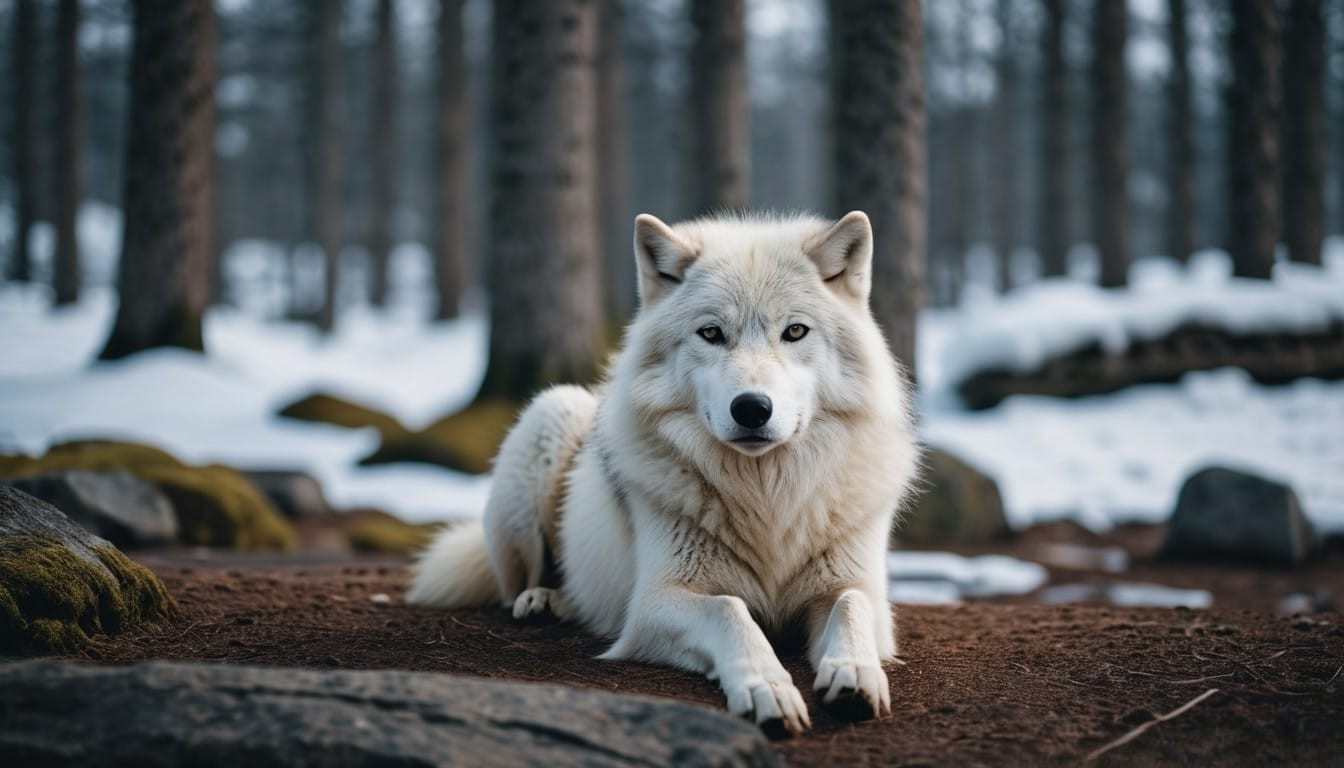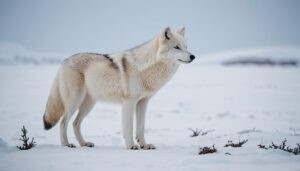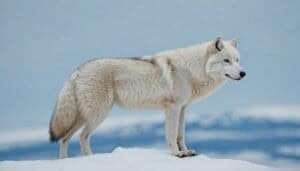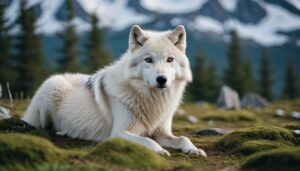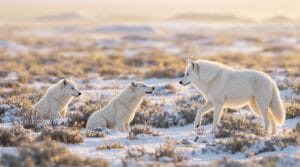Introduction
Arctic wolves play a crucial role in shaping the ecosystem of the Arctic regions
This article explores their influence on the distribution of other Arctic species, focusing on prey population control, herbivorous species behavior, vegetation and biodiversity impacts, and the relationship with migratory and non-prey species
By understanding these dynamics, we can gain insight into the complex interactions within the Arctic ecosystem and the pivotal role Arctic wolves play in maintaining ecological balance. Continue reading to discover the intricate ways in which these apex predators impact their environment and the species that inhabit it
Role of Arctic Wolves in Controlling Prey Populations
Arctic wolves (Canis lupus arctos) significantly influence the populations of their prey species in the Arctic ecosystem. These apex predators primarily hunt medium to large mammals, which plays a critical role in maintaining the balance of the food web
Primary Prey Species and Predation Patterns
Arctic wolves mainly prey on caribou (Rangifer tarandus), Arctic hares (Lepus arcticus), and musk oxen (Ovibos moschatus). Caribou, being the most substantial component of their diet, experience significant population fluctuations due to wolf predation
Wolves typically hunt in packs, which allows them to target larger prey more effectively. This predation behavior not only helps regulate the numbers of these species but also affects their behavior and distribution
For instance, caribou herds often alter their migration routes and timings to avoid wolf packs. Such behavioral changes have cascading effects on other species and the vegetation in those areas. By preying on caribou, Arctic wolves indirectly influence the grazing patterns of these herbivores, which in turn impacts the distribution and composition of Arctic vegetation
Impact on Prey Population Dynamics
The predation pressure exerted by Arctic wolves helps control the population sizes of their prey, preventing overgrazing and maintaining ecological balance
For example, in areas where wolf populations are healthy, caribou and musk oxen numbers are kept in check, reducing the risk of habitat degradation due to overgrazing. This balance is crucial for the sustainability of the Arctic ecosystem
Studies have shown that in regions where wolf populations have declined, there is a noticeable increase in caribou and musk oxen numbers, leading to overgrazing and subsequent damage to the tundra vegetation. This overgrazing can result in soil erosion and loss of plant biodiversity, which affects other species dependent on the same habitat
Examples of Prey Species and Population Control
In a study conducted by the University of Alberta in 2018, researchers observed that areas with stable Arctic wolf populations exhibited more balanced caribou and musk oxen populations compared to areas with reduced wolf numbers
This research highlighted the critical role wolves play in controlling prey populations and maintaining the health of the ecosystem
Additionally, Arctic hares, another primary prey species for wolves, show different population dynamics in the presence of wolves. In regions with high wolf activity, hare populations are more evenly distributed, preventing localized overpopulation and ensuring more sustainable vegetation use
This dynamic helps maintain a diverse and healthy plant community, supporting a wide range of other species
Influence on Herbivorous Species Behavior
Arctic wolves significantly impact the behavior of herbivorous species in their habitat. Through predation pressure and the fear they instill, wolves induce changes in the feeding habits, migration patterns, and overall behavior of these herbivores
This phenomenon, known as the “ecology of fear,” has far-reaching implications for the Arctic ecosystem
Changes in Feeding Habits and Patterns
Herbivorous species such as caribou and Arctic hares alter their feeding habits and patterns in response to wolf presence. When wolves are nearby, these herbivores tend to reduce their grazing in open areas, preferring locations with better cover to avoid detection
This change in grazing behavior can lead to uneven vegetation use, with some areas experiencing less grazing pressure and others being overutilized when wolves are not present
For instance, caribou may avoid lush feeding grounds if they sense wolf activity, leading to an increase in vegetation growth in those areas. Conversely, safer regions may experience higher grazing pressure, potentially leading to overgrazing
This redistribution of grazing pressure helps maintain a mosaic of vegetation patches with varying levels of growth and biodiversity
Effects on Migration and Habitat Use
The presence of Arctic wolves also influences the migration patterns and habitat use of herbivorous species. Caribou, for example, adjust their migration routes and timing to evade wolf packs. This behavior ensures they spend less time in areas where wolves are known to hunt, reducing their risk of predation
Research conducted by the University of Manitoba in 2020 showed that caribou herds in wolf-dense areas altered their migratory paths, opting for longer but safer routes. This shift not only affects the caribou but also influences the distribution of nutrients across the landscape
As caribou move to new areas, they contribute to seed dispersal and nutrient cycling, promoting plant growth and diversity in different regions
Case Studies of Herbivore Adaptations
Several case studies highlight the adaptations of herbivores to the presence of Arctic wolves
One notable example is the musk oxen, which form defensive circles when threatened by wolves. This behavior minimizes the chances of individual animals being isolated and targeted by predators. Such defensive strategies help maintain musk oxen populations, allowing them to thrive even in the presence of predators
Another example is the Arctic hare, which uses its agility and speed to evade wolf attacks. Hares have been observed to change their activity patterns, becoming more nocturnal in regions with high wolf activity. This behavioral shift reduces their exposure to predators and increases their chances of survival
Impact on Vegetation and Biodiversity
Arctic wolves, through their influence on prey species, play a critical role in shaping vegetation distribution and maintaining biodiversity in the Arctic ecosystem
Their predatory behavior affects herbivory pressure on plants, indirectly influencing the composition and health of vegetation, which in turn impacts the biodiversity of the region
Herbivory Pressure and Vegetation Zones
Arctic wolves help regulate herbivory pressure by controlling the population and behavior of herbivores such as caribou and musk oxen
When wolf populations are stable, they limit the number of these large herbivores, preventing overgrazing and allowing vegetation to thrive. This balance is crucial for the maintenance of various vegetation zones within the Arctic
In areas with high wolf activity, herbivores tend to avoid certain regions, reducing grazing pressure and allowing plant communities to recover and flourish
Conversely, in regions with low wolf populations, unchecked herbivore numbers can lead to overgrazing, resulting in vegetation degradation and loss of plant species. This dynamic creates a patchwork of vegetation zones with varying levels of growth and biodiversity
Influence on Smaller Predators and Species Richness
Arctic wolves indirectly impact smaller predators and overall species richness
By controlling the populations of primary herbivores, wolves reduce competition for food resources among smaller predators such as Arctic foxes (Vulpes lagopus) and stoats (Mustela erminea). This allows these smaller predators to maintain stable populations and occupy their ecological niches effectively
Additionally, the carcasses of wolf kills provide scavenging opportunities for a range of species, including birds like ravens (Corvus corax) and snowy owls (Bubo scandiacus)
These scavengers benefit from the presence of wolves, as they have access to a reliable food source, which supports their survival and reproduction. This interaction enhances the overall biodiversity of the Arctic ecosystem by supporting a variety of species at different trophic levels
Examples of Vegetation Changes and Biodiversity
Research conducted by the University of Alaska Fairbanks in 2019 demonstrated the significant impact of wolves on vegetation and biodiversity
In areas with healthy wolf populations, researchers observed higher plant diversity and more robust vegetation growth compared to areas with fewer wolves. This difference was attributed to the controlled grazing pressure exerted by herbivores in the presence of wolves
One notable example is the tundra willow (Salix spp.), which thrives in regions with balanced herbivory pressure. In areas with high wolf activity, willow populations were more robust and diverse, providing essential habitat and food for other species such as ptarmigans (Lagopus spp.) and voles (Microtus spp.)
This cascading effect highlights the importance of wolves in promoting plant diversity and supporting a rich array of Arctic wildlife
Relationship with Migratory Patterns and Non-Prey Species
Arctic wolves influence the migratory patterns of their prey and interact with non-prey species in ways that impact the broader Arctic ecosystem. Their presence affects seasonal movements, migration routes, and the dynamics of various non-prey species, contributing to the overall ecological balance
Seasonal Movements of Prey Species
Arctic wolves significantly impact the seasonal movements of prey species such as caribou and musk oxen
These herbivores often migrate vast distances to find food and breeding grounds, and the presence of wolves shapes these movements. Wolves’ predation pressure and territorial behaviors create a landscape of fear that prey species navigate to avoid encounters
For example, caribou herds tend to avoid areas with known wolf dens during calving season, opting for safer regions despite the potential for less optimal feeding grounds. This behavior ensures lower predation rates on calves and influences the distribution of caribou populations across the Arctic landscape
Impact on Migration Routes and Timing
The migration routes and timing of prey species are directly influenced by the presence of Arctic wolves. Studies have shown that caribou adjust their migration timing to avoid peak wolf hunting periods, which usually coincide with the early spring when caribou are weaker and more vulnerable after the long winter
Research conducted by the University of Calgary in 2021 revealed that caribou herds delayed their spring migration by up to two weeks in areas with high wolf activity
This adjustment reduced predation pressure but also led to changes in grazing patterns and habitat use, affecting the vegetation and other species in those areas
Indirect Effects on Non-Prey Species
Arctic wolves also have indirect effects on non-prey species through their predation activities and the ecological changes they induce
For instance, wolf kills provide carcasses that serve as food sources for scavengers like ravens and snowy owls. This scavenging opportunity supports these birds’ populations, which rely on the availability of carcasses, especially during the harsh winter months
Additionally, the presence of wolves can influence the behavior of non-prey species. For example, smaller predators such as Arctic foxes and stoats may benefit from reduced competition with larger predators like wolves for prey and territory. This dynamic allows these smaller predators to thrive and maintain their ecological roles, contributing to the overall biodiversity of the Arctic ecosystem
Indirect Effects on Non-Prey Species
Arctic wolves, through their predation and presence, create a ripple effect that influences non-prey species within their ecosystem. These indirect effects contribute to the ecological balance, impacting scavengers, bird populations, and other wildlife in complex ways
Scavengers and Decomposers
The carcasses left behind by Arctic wolves provide a vital food source for a range of scavengers and decomposers
Species such as ravens, Arctic foxes, and snowy owls benefit from the availability of these carcasses, particularly during the harsh winter months when food is scarce. The presence of wolf kills ensures that these scavengers can sustain themselves and continue to play their role in the ecosystem
For example, ravens are often seen at wolf kill sites, taking advantage of the remains. This reliable food source helps maintain raven populations, which in turn contribute to the ecological balance by cleaning up carrion and helping to recycle nutrients back into the soil
Similarly, Arctic foxes, which might struggle to find food during winter, rely on wolf kills to survive, ensuring their continued presence and role in the Arctic food web
Effects on Bird Populations
Arctic wolves indirectly influence bird populations through their predation activities
By controlling herbivore populations, wolves reduce grazing pressure on vegetation, which can lead to healthier and more diverse plant communities. These plant communities provide habitat and food for various bird species, supporting their populations
For instance, ground-nesting birds like the Lapland longspur (Calcarius lapponicus) benefit from the increased vegetation cover that results from balanced grazing pressure. Healthier vegetation provides better nesting sites and protection from predators, leading to higher reproductive success for these birds
This cascading effect highlights the importance of wolves in maintaining the conditions necessary for diverse bird populations
Examples of Non-Prey Species Interactions
Several studies illustrate the indirect effects of Arctic wolves on non-prey species
One notable example is the interaction between wolves and the Arctic fox. While both species are predators, they occupy different ecological niches and can coexist due to the wolves’ regulation of larger herbivore populations. This dynamic reduces competition for resources, allowing both species to thrive
Another example is the role of wolves in supporting the nutrient cycle within the Arctic ecosystem. The carcasses of wolf prey provide a concentrated source of nutrients that enrich the soil, promoting plant growth and supporting a wide range of species
Decomposers, such as bacteria and fungi, break down these carcasses, releasing nutrients that are then taken up by plants, which in turn support herbivores and other wildlife
Conclusion
Arctic wolves play a crucial role in shaping the dynamics of the Arctic ecosystem. Their predatory behavior impacts the distribution and behavior of herbivorous species, such as caribou and musk oxen, leading to changes in feeding habits, migration patterns, and habitat use
These changes, in turn, influence vegetation distribution and biodiversity, promoting a balanced and diverse plant community that supports various wildlife species
Furthermore, the presence of Arctic wolves affects smaller predators and non-prey species, creating a ripple effect that enhances the ecological balance. Scavengers and decomposers benefit from the carcasses left by wolves, contributing to nutrient cycling and supporting a rich array of species
Bird populations and other wildlife are also indirectly influenced by the wolves’ regulation of herbivore populations, highlighting the interconnectedness of the Arctic ecosystem
By understanding the multifaceted influence of Arctic wolves on the distribution of other Arctic species, we gain valuable insights into the importance of apex predators in maintaining ecological stability. The intricate relationships between wolves, their prey, and the broader environment underscore the need to protect and preserve these critical components of the Arctic ecosystem
